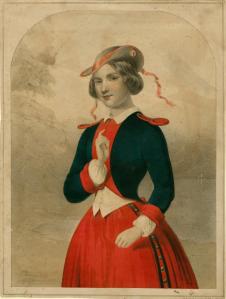
The Jenny Lind crossroads in Lenoir County, N.C. Photo from the Historical Preservation Group (Lenoir County)
Last night I saw a scene on PBS’s drama Victoria in which the Swedish opera star Jenny Lind sang for Queen Victoria. That was an actual event: it happened on April 26, 1846. But of course I thought immediately of the little community called “Jenny Lind” that is located 10 miles west of Kinston, in Lenoir County, N.C. According to legend, Jenny Lind sang there, too.
Her full name was Johanna Maria Lind. She was born in Stockholm, Sweden, in 1820 and became one of the greatest sopranos of the 19th century. She was widely known as the “Swedish Nightingale.”
She was wildly popular– Beatles popular. She also worked with and inspired many other great artists. She toured with Felix Mendelssohn and many people have suspected that they were lovers. She sang for Chopin when he was dying.
And Hans Christian Andersen totally lost it over her—he always considered her a muse.
Jenny Lind’s U.S. Tour
Jenny Lind toured widely in Europe, and in 1850 P. T. Barnum—he of circus fame—brought her to America for what became a phenomenally successful tour. She donated her profits from the tour to a variety of good causes, mainly to support free schools in her native Sweden, but also local charities here.
She stayed in the U. S. for two years and gave more than 100 performances in opera halls and theaters across the country.

Portrait of Jenny Lind by Eduard Magnus, 1862. From the National Portrait Gallery, London.
According to legend, she also performed at least a song or two beneath an old oak tree in a little farm community in Lenoir County, N.C.
The community was located just east of Bear Creek, a stream that flows into the Neuse River, maybe 60 miles southeast of Raleigh. The date– again, according to legend– was 1850.
As the story goes, Lind was on tour and her stagecoach broke down there.
While the stagecoach was being repaired—so the story goes—Ms. Lind took shelter from the sun beneath the oak and sang for a crowd of farm families that gathered to see her.
In Queen Victoria’s Words
If the story is true, those country people had a special experience.

Crowds gathered to see Jenny Lind depart from Liverpool to come to the U.S. for her tour in 1850. The Illustrated London News, 24 Aug. 1850.
After hearing Jenny Lind perform, Queen Victoria wrote in her diary—
The great event of the evening was Jenny Lind’s appearance and her complete triumph. She has a most exquisite, powerful, and really quite peculiar voice, so round, soft, and flexible.”
During Lind’s U.S. tour, Emily Dickinson also heard Lind sing—that was on July 3, 1851, in Northampton, Mass. The great poet was apparently unaccustomed to operatic music, but she was completely taken by Lind.
Of that evening, Dickinson wrote—
“How we all loved Jenny Lind…. Herself, and not her music, was what we seemed to love—she has an air of exile in her mild blue eyes, and a something sweet and touching in her native accent which charms her many friends.”
Under the Old Oak
I’ve never seen a written account of Lind’s visit to Lenoir County—or, for that matter, any documentation of any kind that confirms that Jenny Lind was ever waylaid in Lenoir County.

Drawing of Jenny Lind from her U.S. tour. Courtesy, New York Public Library
In fact, I have found no record of the famous soprano ever performing anywhere in North Carolina, though I did find a reference to her passing through Wilmington on her way to Charleston, S.C.
Nevertheless I hope the story is true! I can’t resist the thought that one of the 19th century’s most famous opera singers paused at a crossroads in Lenoir County and shared her music with the local people.
In my imagination, I see the weathered faces of the farmers and their wives, the crowds of children, the curious field hands. Some of them, of course, were probably enslaved African Americans– maybe most of them.
In my mind’s eye, I see them all gathered under that old oak. Young and old, black and white, they are listening to the Swedish Nightingale.
Maybe she sang a piece from Mendelssohn’s Elijah or one of the soul stirring arias from The Marriage of Figaro—Lind’s contemporary critics said she excelled at Mendelssohn and Mozart.
Maybe like me the night I first heard Tosca, they cried like little children.
It must have been a rare and unexpected delight. When the roosters crowed that morning, they had greeted a day that seemed like any other—and then they discovered music like no other, and beauty beyond words.
No wonder, if that really is what happened, that they changed the name of their little home to Jenny Lind.
Dear David, what a fun story! thank you!
love, Lanier
LikeLiked by 2 people
David, What a sweet and lovely story about Jenny Lind. I, for one, believe it’s true, wholeheartedly.
Susan
LikeLiked by 1 person